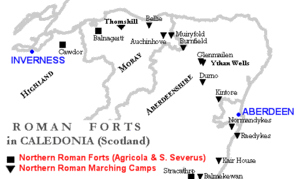Raedykes facts for kids

Raedykes is the site of an ancient Roman marching camp in Scotland. It is located about 5 kilometers (3 miles) northwest of Stonehaven, in Aberdeenshire. This site is a scheduled monument, which means it is protected for its historical importance.
A marching camp was like a temporary military base. Roman soldiers built these camps for overnight stops during long journeys. They also used them as temporary bases when fighting in new or unfriendly areas.
Contents
Discovering the Raedykes Camp
Historians believe Raedykes was built around the late 1st century AD. This was during the time of a Roman general named Gnaeus Julius Agricola. Some experts think it might be from the 2nd century (Antonine period) or early 3rd century (Severan period).
Where is Raedykes Located?
The camp is built on Garrison Hill, which is 191 meters (628 feet) high. This hill offers great views over the Cowie Water valley, a small river that flows into the North Sea. The camp's walls, called a vallum, surround the top and eastern side of the hill.
How Big Was the Camp?
Raedykes camp covered about 37 hectares (93 acres). This is a very large area! Computer models suggest it was big enough to hold three full Roman legions. That means around 16,000 soldiers could have stayed there.
Camp Shape and Entrances
The camp's outer wall follows the shape of the land, so it's not a perfect square or circle. It has an irregular shape. There were six gates, and five of them are still visible today. Each gate was protected by special defenses called titulus outworks. These were ditches and mounds built in front of the gate to make it harder for enemies to enter.
Raedykes was strategically placed. It was a day's march north from another Roman fort at Stracathro. It was also just a few hours' march south of Normandykes, another Roman camp.
Roman History in Scotland
The Roman army built many forts and camps across Scotland in the late 1st century AD. These included places like Ardoch, Strageath, Inchtuthil, Battledykes, Stracathro, Raedykes, Normandykes, Glenmailen, Bellie, Balnageith, and Cawdor. Many of these sites were used again about a century later, during the time of Emperor Septimius Severus.
The Battle of Mons Graupius
In the summer of 84 AD, General Agricola led the Roman army to a major victory. They defeated a large army of Caledonians, who were the native people of Scotland. This battle is known as the battle of Mons Graupius. It's possible that a leader named Calgacus led the Caledonians.
The exact location of the Battle of Mons Graupius is still a mystery. Some experts, like Gabriel Jacques Surenne, believe it might have happened near Raedykes, possibly around Kempstone Hill. Another possible site is Bennachie, a prominent hill much further north, near the Roman camp at Durno. However, there is no clear evidence to pinpoint the exact battle site.


